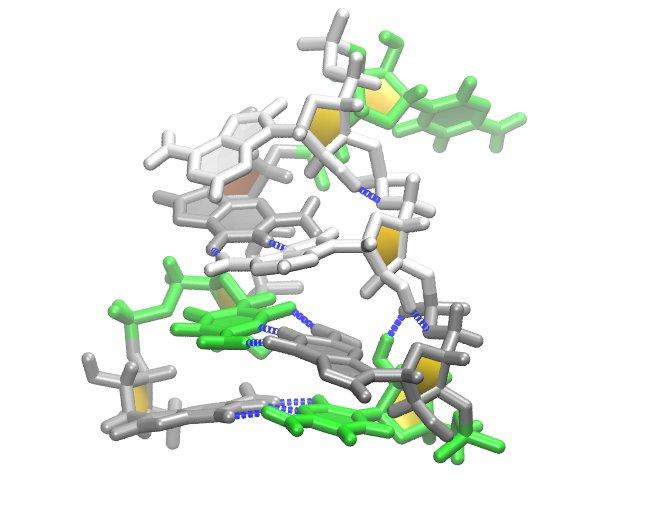RNA simulations boost understanding of retroviral diseases

Z-state: An example of RNA folded into a tetraloop, in this case the "Z-form duplex" under study that could provide medical treatment opportunities for retroviral diseases such as Zika and Ebola. RNA nucleobases are colored using this key (Gray: Guanosine, Green: Cytosine, White: Adenosine). Hydrogen bonds are shown in blue. The sequence is gcGCAAgc (capitals indicate residues forming the loop). Credit: Los Alamos National Laboratory
New molecular dynamics research into how RNA folds into hairpin-shaped structures called tetraloops could provide important insights into new treatments for retroviral diseases.
“Ribonucleic acid, known as RNA, forms the genome of multiple viruses that afflict humans, including Ebola, HIV and Zika, which are active areas of research at Los Alamos,” said Jacob Miner, a Los Alamos National Laboratory graduate student in the Center for Nonlinear Studies and a member of the research team. “Being able to describe the structures and thermodynamic behaviors of these and other RNA molecules is critical for us as scientists to understand life at microscopic levels and to effect suitable measures to treat diseases.”
“One of the most exciting discoveries in our computer models is the emergence of a particular type of tetraloop that we thought only formed in highly saline environments,” said Miner. “Our results show that similar sequences may be spontaneously forming these tetraloops, called Z-form duplexes, in nature, providing a potential target for treating retroviral diseases,” he noted.
Research at Los Alamos has advanced the science of molecular biology over the years through such efforts as using the Laboratory's supercomputers to create the world's largest computational biology simulation of ribosomes in action. Another project, detecting pathogens through RNA screening, has recently been opened up for corporate partnering. In addition, Los Alamos scientists are teaming with other institutions in human trials of a complex mosaic approach to a globally applicable HIV vaccine. Biological research, especially in disease forecasting and treatment, aids in national security in preventing or minimizing the effect of epidemics and stabilizing the health of the nation.
For the new RNA research, Miner and a team from Rensselaer Polytechnic Institute and the State University of New York, Albany pursued a goal of the nucleic-acid modeling community, that of understanding the various structures that linear chains of RNA molecules can form. While DNA has the well-known “double helix” structure, RNA's single chain permits it to writhe and contort into completely different shapes, each giving the RNA a different function, such as coding and decoding genes or building proteins.
The prevalence of one RNA configuration over another is driven by its thermodynamic stability, and the relative populations of these configurations can be modulated by changes in the solution environment such as temperature, pressure, ions and the presence of other molecules.
Molecular dynamics (MD), which allows scientists to model detailed molecular interactions of RNA with itself and solution, has proven to be one of the most useful tools in understanding the modulation of RNA configurations, Miner said. “The behaviors exhibited in MD simulations can be extended to describe macroscale thermodynamic properties in all manner of RNA structures. In the case of our research, it represents a significant advancement in the utility of RNA molecular dynamics for describing RNA thermodynamics.”
###
The paper, “Free-energy landscape of a hyperstable RNA tetraloop,” appears in the Proceedings of the National Academy of Sciences. Its authors are Jacob C. Miner of Los Alamos; Alan A. Chen of the State University of New York, Albany, and Angel E. García of Los Alamos and Rensselaer Polytechnic Institute.
These simulations were conducted using the TACC Stampede Supercomputer through the Extreme Science and Engineering Discovery Environment with support from National Science Foundation (NSF) Grant MCB-137078 and NIH Biotechnology Training Grant 5T32GM067545- 08/9. This work was funded by NSF Grant MCB-1050906 and US DOE LDRD funds.
About Los Alamos National Laboratory
Los Alamos National Laboratory, a multidisciplinary research institution engaged in strategic science on behalf of national security, is operated by Los Alamos National Security, LLC, a team composed of Bechtel National, the University of California, BWXT Government Group, and URS, an AECOM company, for the Department of Energy's National Nuclear Security Administration.
Media Contact
All latest news from the category: Life Sciences and Chemistry
Articles and reports from the Life Sciences and chemistry area deal with applied and basic research into modern biology, chemistry and human medicine.
Valuable information can be found on a range of life sciences fields including bacteriology, biochemistry, bionics, bioinformatics, biophysics, biotechnology, genetics, geobotany, human biology, marine biology, microbiology, molecular biology, cellular biology, zoology, bioinorganic chemistry, microchemistry and environmental chemistry.
Newest articles

NASA: Mystery of life’s handedness deepens
The mystery of why life uses molecules with specific orientations has deepened with a NASA-funded discovery that RNA — a key molecule thought to have potentially held the instructions for…

What are the effects of historic lithium mining on water quality?
Study reveals low levels of common contaminants but high levels of other elements in waters associated with an abandoned lithium mine. Lithium ore and mining waste from a historic lithium…

Quantum-inspired design boosts efficiency of heat-to-electricity conversion
Rice engineers take unconventional route to improving thermophotovoltaic systems. Researchers at Rice University have found a new way to improve a key element of thermophotovoltaic (TPV) systems, which convert heat…



